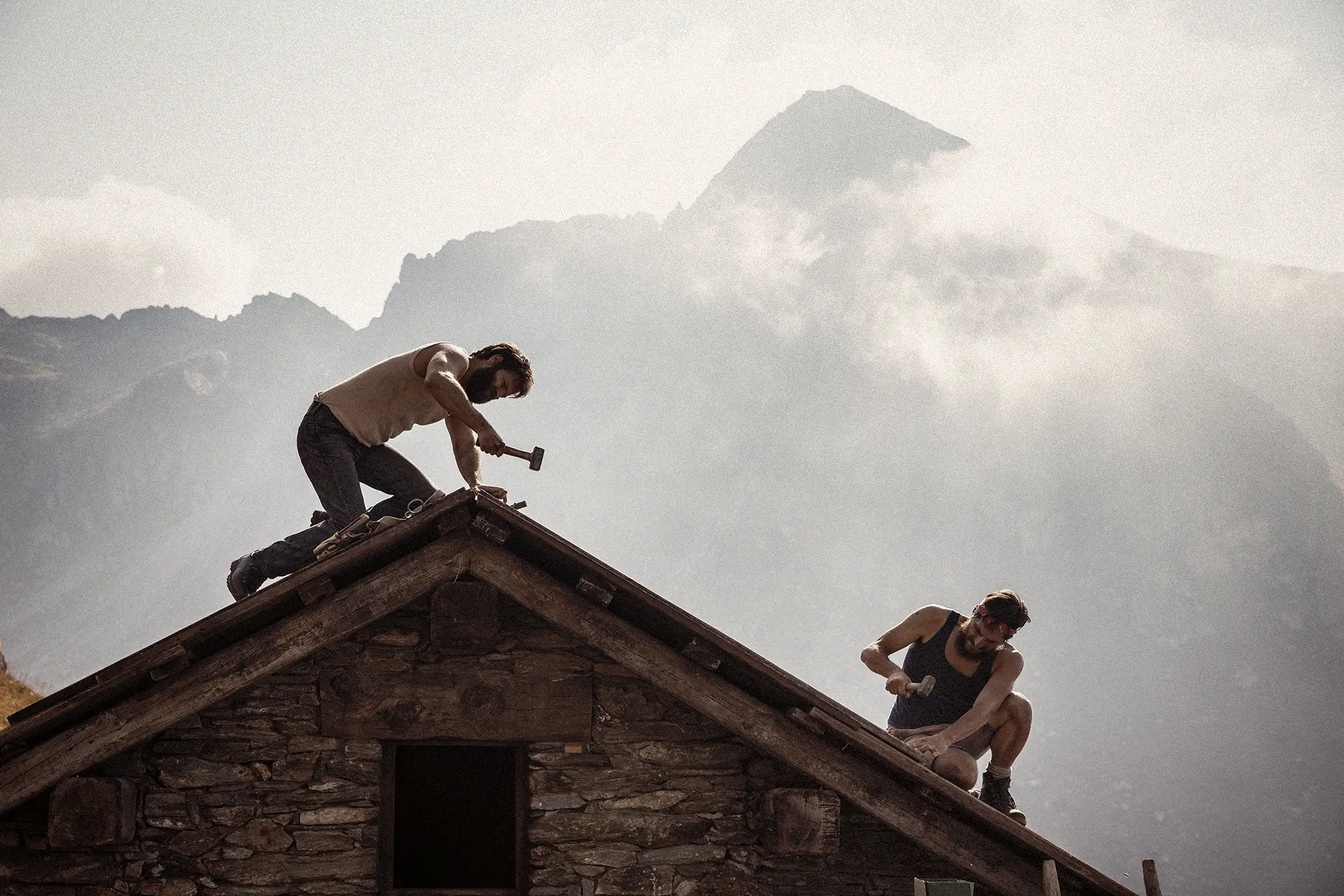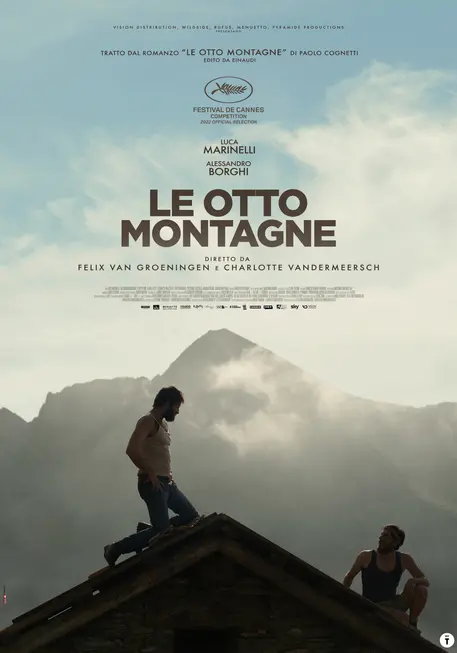
We use cookies
We use cookies and other tracking technologies to improve your browsing experience on our website, to show you personalized content and targeted ads, to analyze our website traffic, and to understand where our visitors are coming from.

“We say that at the centre of the world is the highest mountain, Mount Sumeru. There are eight mountains and eight seas around Mount Sumeru. This is the world for us.”
The directors of The Eight Mountains (Le otto montagne) wanted to show the very places described by Paolo Cognetti in his 2017 Strega Prize-winning novel. The main setting, therefore, had to be Val d’Aosta where Felix van Groeningen and Charlotte Vandermeersch lived for a year to absorb its essence.
One childhood summer, Pietro meets Bruno, the last child in the isolated mountain village of Graines (or Grana, a hamlet of Brusson in val d’Ayas). “The village seemed to be made of the same grey stone as the mountain and nestled against it like a rocky outcropping, an ancient landslide: a little further up, the goats were grazing”. Pietro’s parents rent a house here: the location was the old school house transformed today into a museum of local history by the Consorteria of Graines. It was restructured and expanded with European funding and the contribution from the production in exchange for use of the location.
Bruno, meanwhile, spends his summer with his uncle in a mountain hut in Lavassey at 2,000 m, an hour’s walk from Estoul, which he buys back as an adult. A longer walk is required to reach Barma Drola, where Pietro builds his house with Bruno’s help: the location was a ruined, privately owned Alpine hut in Merendioux which the production partially restructured. Facing Barma Drola is mount Bieteron, which the locals call Grenon: “the mountain of Grana”. They do the same with lake Grenon, actually lake Frudieres, which is situated a 120/150-minute walk from Graines.
Despite only seeing each other in the summer, Pietro and Bruno forge a strong bond as children while exploring the nature that surrounds them: the mill where they try to roll a wheel into the river is a disused building in Brusson. Here again, in a bar (Bar Restaurant La Boule), they meet briefly as adolescents when their lives seem to have taken very different directions. The restaurant belonging to Lara, who comes into their lives as adults, is located in Estoul (Il pranzo di Babette).
One of the key events in Pietro’s childhood is an expedition to the glacier with his father and Bruno. The three spend the night in the Mezzalama refuge, heading to their destination the next morning. Sensitive to the altitude, Pietro is taken ill on the glacier, just in front of a crevasse: the scene was shot in the colle Felik area of the mount Rosarange. Scenes from their journey there were shot in pian di Verra in Champoluc, which faces mount Rosa.
Alternating with the mountains, the second soul of the story is the city, perceived at various times as asphyxiating, distant or liberating. The production also shot in the protagonist’s work places in Turin: in the Le Vigne Restaurant in the quadrilatero romano, the Mad Dog Social Club in the centre and corso Trieste in the city.
Part of the film is set in Nepal.
“We say that at the centre of the world is the highest mountain, Mount Sumeru. There are eight mountains and eight seas around Mount Sumeru. This is the world for us.”
The directors of The Eight Mountains (Le otto montagne) wanted to show the very places described by Paolo Cognetti in his 2017 Strega Prize-winning novel. The main setting, therefore, had to be Val d’Aosta where Felix van Groeningen and Charlotte Vandermeersch lived for a year to absorb its essence.
One childhood summer, Pietro meets Bruno, the last child in the isolated mountain village of Graines (or Grana, a hamlet of Brusson in val d’Ayas). “The village seemed to be made of the same grey stone as the mountain and nestled against it like a rocky outcropping, an ancient landslide: a little further up, the goats were grazing”. Pietro’s parents rent a house here: the location was the old school house transformed today into a museum of local history by the Consorteria of Graines. It was restructured and expanded with European funding and the contribution from the production in exchange for use of the location.
Bruno, meanwhile, spends his summer with his uncle in a mountain hut in Lavassey at 2,000 m, an hour’s walk from Estoul, which he buys back as an adult. A longer walk is required to reach Barma Drola, where Pietro builds his house with Bruno’s help: the location was a ruined, privately owned Alpine hut in Merendioux which the production partially restructured. Facing Barma Drola is mount Bieteron, which the locals call Grenon: “the mountain of Grana”. They do the same with lake Grenon, actually lake Frudieres, which is situated a 120/150-minute walk from Graines.
Despite only seeing each other in the summer, Pietro and Bruno forge a strong bond as children while exploring the nature that surrounds them: the mill where they try to roll a wheel into the river is a disused building in Brusson. Here again, in a bar (Bar Restaurant La Boule), they meet briefly as adolescents when their lives seem to have taken very different directions. The restaurant belonging to Lara, who comes into their lives as adults, is located in Estoul (Il pranzo di Babette).
One of the key events in Pietro’s childhood is an expedition to the glacier with his father and Bruno. The three spend the night in the Mezzalama refuge, heading to their destination the next morning. Sensitive to the altitude, Pietro is taken ill on the glacier, just in front of a crevasse: the scene was shot in the colle Felik area of the mount Rosarange. Scenes from their journey there were shot in pian di Verra in Champoluc, which faces mount Rosa.
Alternating with the mountains, the second soul of the story is the city, perceived at various times as asphyxiating, distant or liberating. The production also shot in the protagonist’s work places in Turin: in the Le Vigne Restaurant in the quadrilatero romano, the Mad Dog Social Club in the centre and corso Trieste in the city.
Part of the film is set in Nepal.

Wildside, Pyramide productions, Rufus, Menuetto film, Vision Distribution